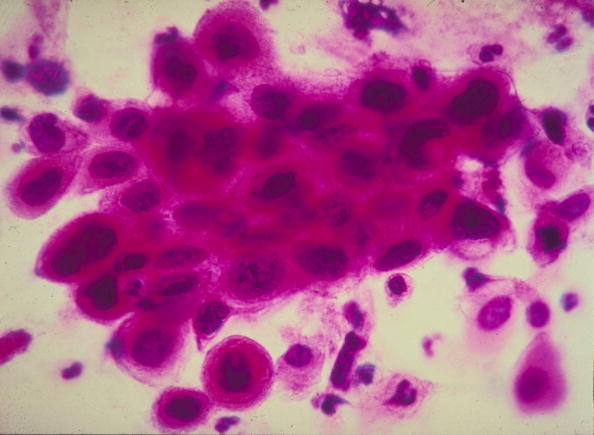In 2023, pancreatic cancer claimed approximately 50,550 lives in the United States, making it the fourth leading cause of cancer-related deaths for both genders, contributing to seven percent of such fatalities.

(Photo : Photo by American Cancer Society/Getty Images)
Close up of cancer cells in the cervix. Cancer of the uterine cervix, the portion of the uterus that is attached to the top of the vagina.
Boosting Microscopic Pancreatic Cancer Screening
A breakthrough has emerged from researchers at the OU Health Stephenson Cancer Center at the University of Oklahoma Health Sciences, who have successfully devised an innovative method to enhance the detection of pancreatic cancer.
Interesting Engineering reports show that this method involves a novel imaging approach that combines a newly formulated contrast agent with multispectral ophthalmography (MSOT).
Detecting pancreatic cancer at the microscopic level is an intricate challenge due to its elusive nature, as highlighted by Ajay Jain, M.D., a professor of surgery at the OU College of Medicine.
Typically diagnosed at an advanced stage with poor outcomes, pancreatic cancer presents a mere nine percent overall chance of survival. Surgical and chemotherapy interventions offer the best odds, but the success of surgery hinges on complete cancer removal-a challenging feat.
This technique enables the identification of pancreatic cancer cells at the microscopic level, approximately 200 microns in size. This marks significant progress compared to current imaging methods, such as CT scans, typically around a centimeter in size.
This innovative imaging approach not only holds promise for enhancing surgical outcomes but also offers the potential for real-time information to guide surgeons during procedures. It could also serve as a valuable screening tool for individuals at high risk of pancreatic cancer.
Also Read: Scientists Leverage Nanomachines to Explore a New Cancer Treatment
Dr. Lacey McNally, a respected professor of surgery at the OU College of Medicine, has played a pivotal role in this advancement. She has developed a unique contrast agent specifically designed to target pancreatic cancer cells.
This tailored agent brings a new level of precision to the detection and imaging of pancreatic cancer, offering a more nuanced and detailed understanding that can significantly impact both surgical interventions and early screening efforts.
Improving Accuracy
The potential applications of this breakthrough span from improved surgical accuracy to the prospect of identifying pancreatic cancer at its earliest stages in high-risk individuals, as reported by News Medical.
The researchers elucidated that the contrast agent, administered through an IV, can effectively differentiate pancreatic cancer cells due to their unique acidic environment. The dye within the contrast agent activates in response to this acidity, effectively illuminating the cancer cells.
Conversely, the MSOT component introduces infrared light into the body, activating the contrast agent. This activation produces sound waves captured by the MSOT device, converting them into colors and generating highly detailed images.
This combined approach significantly enhances the precision of detection, surpassing the capabilities of current imaging methods and providing crucial real-time information for surgeons during operations.
Beyond its applications in surgery, this holds promise as a screening tool for individuals at a heightened risk of pancreatic cancer, including those with a family history or genetic predisposition.
Dr. Jain stressed the importance of early detection for pancreatic cancer, asserting that it provides the best chance for a cure. Detecting cancer at an early, microscopic stage could potentially make it curable.
Related Article: FDA Greenlights First AI-Powered Device to Detect All 3 Common Skin Cancers






